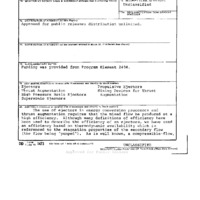-
Title
-
Characteristics of High Performance Ejectors
-
Date
-
1982
-
Index Abstract
-
Coming Soon
-
Photo Quality
-
Not Needed
-
Report Number
-
AFWAL TR 81-3170
-
Corporate Author
-
University of Dayton Research Institute
-
Laboratory
-
Flight Dynamics Laboratory
-
Date Issued
-
1982-01-01
-
Extent
-
99
-
Identifier
-
ADA118720
-
Access Rights
-
Approved for public release; distribution unlimited
-
Distribution Classification
-
1
-
Contract
-
F33615-81-K-3017
-
DoD Project
-
2404
-
DoD Task
-
240410
-
DTIC Record Exists
-
No
-
Distribution Change Authority Correspondence
-
None
-
Abstract
-
The use of ejectors in energy conversion processes and thrust augmentation requires that the mixed flow be produced at a high efficiency. Although many definitions of efficiency have been used to describe the efficiency of an ejectors, we have used an efficiency based on thermodynamic availability which is referenced to the stagnation properties of the secondary flow (the flow being 'pumped'). As is well known, a compressible-flow, control-volume approach to analyzing a constant area ejector yields two solutions: one with a subsonic mixed flow and one with a supersonic mixed flow. The supersonic mixed flow produces the best efficiencies and highest total pressures. The properties of the supersonic mixed flow are of necessity related to the properties of the subsonic mixed flow by the normal shock relations. Nonetheless, in practice, the subsonic mixed flow is, in general, not achieved through a normal shock (or pseudo-normal shock) from the supersonic mixed flow solution. A model is presented that gives a physical interpretation to the various solutions obtained from the mathematics, and more importantly, some fundamental limits are presented and a procedure is developed for determining the efficiency that can be achieved in a constant area ejector when the mixed flow is supersonic.
-
Report Availability
-
Full text available
-
Provenance
-
AFRL/VACA
-
Type
-
report
-
Format
-
1 online resource
-
Creator
-
Minardi, J. E.
 AFWALTR81-3170.pdf
AFWALTR81-3170.pdf